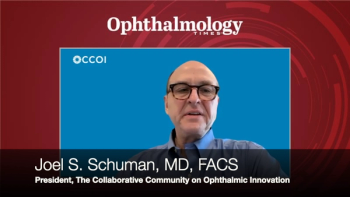
Blog: Cannabinol, a rare cannabinoid, shows unique therapeutic potential in glaucoma
A recent study of cannabinol in in vitro and in vivo glaucoma models, demonstrated encouraging results that may address some of the previous challenges associated with cannabis use and may present a new potential therapeutic intervention in the treatment of glaucoma.
Editor's note: The views expressed in this blog are those of their respective contributor and do not represent the views of Ophthalmology Times® or MJH Life Sciences®
For more than 50 years, cannabis has been the subject of debate for its use as a potential treatment option for glaucoma.
Several studies have shown cannabis’ effect to lower IOP1,2, but there are multiple risks associated with smoking marijuana, such as the short therapeutic window leading to frequent dosing requirements, tachyphylaxis and intoxicating effects from tetrahydrocannabinol (THC), that may counteract any benefit gained.
In addition, the American Academy of Ophthalmology does not support the use of marijuana for the treatment of glaucoma, noting the absence of scientific evidence. However, the mounting scientific evidence of its IOP-lowering effects warrants further research.
A recent study (InMed Pharmaceuticals in collaboration with the University of British Columbia) of cannabinol (CBN), a rare cannabinoid, in in vitro and in vivo glaucoma models, demonstrated encouraging results that may address some of the previous challenges associated with cannabis use and may present a new potential therapeutic intervention in the treatment of glaucoma.
Cannabinoid shows› IOP-lowering and neuroprotective effects
The intoxicating effects of marijuana, stemming from its THC content, has been an obstacle to its therapeutic use3. CBN is a rare cannabinoid and, unlike THC, CBN is generally regarded as non-intoxicating. In this most recent study, researchers used synthetically produced CBN and tested it against a panel of various cannabinoids.
The results, published in a peer-reviewed scientific article entitled “Cannabinol Modulates Neuroprotection and Intraocular Pressure:Potential Multi-Target Therapeutic Intervention for Glaucoma”, showed that CBN was able to provide direct neuroprotection of the retinal ganglion cells (RGCs) as well as modulate intraocular pressure (Figure 1). In addition, CBN demonstrated superior neuroprotective and IOP-lowering effects over other cannabinoids, including THC and cannabidiol (CBD).
CBN may activate multiple human receptors, including receptors in the endocannabinoid system
While the specific molecular mechanisms are not yet fully understood, it is suggested that cannabinoids lower IOP through cannabinoid receptor 1 (CB1)1, and activation of cannabinoid receptor 2 (CB2), may lead to neuroprotective effects and reduced inflammation.
Research suggests that CBN is a potential agonist of CB1, CB2, vanilloid receptors and other neurotransmitter receptors (Figure 2). Consistent with the outcomes in most cannabis-related glaucoma research, this study showed that CBN also lowered IOP, further validating the IOP-lowering effects of certain cannabinoids.
Neuroprotective effects - a potentially new added medical benefit
What’s notable in this study was CBN’s direct neuroprotective effects. Cell viability was examined in RGCs. Under normal atmospheric pressure, CBN enhanced cell viability and under elevated pressure, CBN significantly decreased the pressure-induced cytotoxicity. In contrast, all the other cannabinoids tested, including THC and CBD, showed no significant neuroprotective effects. The neuroprotective evidence is a potential enhanced treatment benefit versus existing medications which mainly address the reduction of IOP. A glaucoma treatment providing proactive protection of the retina could slow the progression of optic nerve damage and reduce the risk of blindness.
Longer therapeutic window than previous studies of cannabis use
Previous cannabis-related glaucoma studies indicated a short therapeutic window of three to four hours requiring frequent dosing, making it impractical for a chronic condition like glaucoma. Those studies were mainly focused on THC or marijuana containing high levels of THC. To understand the therapeutic window of CBN, a study reviewed CBN’s pharmacokinetic profile. Results demonstrated that CBN had a broader therapeutic window than THC and had a long ocular tissue half-life, suggesting a potentially longer therapeutic window than previous studies of cannabis.
Formulation supports enhanced drug delivery
Cannabinoids are known to have poor bioavailability due to low aqueous solubility. Previous unsuccessful attempts for topical ocular delivery of cannabinoids used mineral oil formulations. InMed’s CBN formulation, named INM-088, uses a topical microemulsion eyedrop delivery technology called MiDROPS (EyeCRO LLC) and is designed to deliver lipophilic molecules to the anterior and posterior segments of the eye. This CBN formulation may improve drug delivery to the retina, have a greater therapeutic window and likely reduce systemic adverse effects, including tachyphylaxis.
Addressing the multiple challenges of cannabis use for treating glaucoma
In U.S. states where marijuana use is permitted, it continues to be used as an alternative medicine in the treatment of glaucoma, but challenges of a short therapeutic window, intoxicating effects of marijuana, and tachyphylaxis make it impractical for long term use.
This CBN study has shown a longer therapeutic window, uses a non-intoxicating cannabinoid, and its topical formulation may minimize issues of tachyphylaxis. This CBN study also represents the first time that any cannabinoid has demonstrated pro-survival and neuroprotective effects of the retinal cells, a therapeutic benefit that sets it apart not only from other cannabinoids studied so far, but also existing glaucoma therapies that work to mainly address reducing IOP. Based on these results, a clinical program is currently under development.
Peter Hnik, MD, is a trained ophthalmologist and President and Owner of Clinscape Consulting Inc. He is a consultant to InMed Pharmaceuticals Inc.
References
1 Br j Ophthalmol. 2004 May; 88(5): 708–713. doi: 10.1136/bjo.2003.032250
2 Song ZH, Slowey CA. Involvement of cannabinoid receptors in the intraocular pressure- lowering effects of WIN55212-2. J Pharmacol Exp Ther 2000;292(1):136-9
3 Merritt JC, Perry DD, Russell DN, Jones BF. Topical delta 9-tetrahydrocannabinol and aqueous dynamics in glaucoma. J Clin Pharmacol 1981;21(S1):467S-71S.
4 F.Y. Chien, R.F. Wang, T.W. Mittag, S.M. Podos, Effect of WIN 55212-2, a cannabinoid receptor agonist, on aqueous humor dynamics in monkeys, Archives of ophthalmology, 121 (2003) 87-90.
5 I. Tomida, R.G. Pertwee, A. Azuara-Blanco, Cannabinoids and glaucoma, The British journal of ophthalmology, 88 (2004) 708-713.
Newsletter
Don’t miss out—get Ophthalmology Times updates on the latest clinical advancements and expert interviews, straight to your inbox.













































